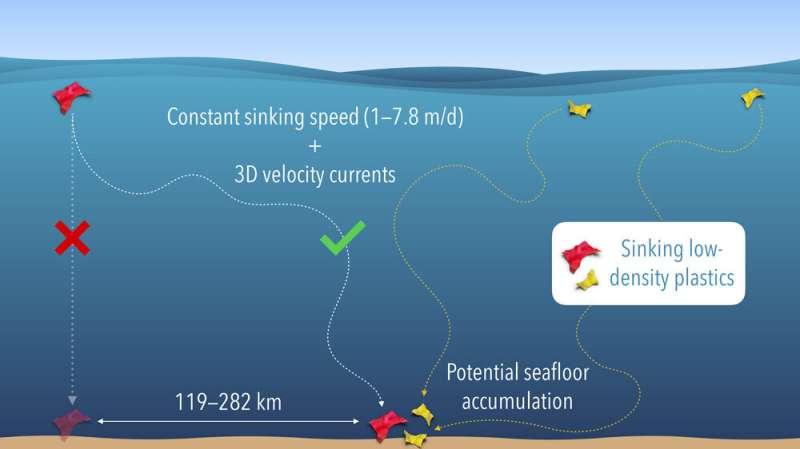This article has been reviewed according to Science X's editorial process and policies. Editors have highlighted the following attributes while ensuring the content's credibility:
fact-checked
peer-reviewed publication
trusted source
proofread
Modeling study shows plastic can drift far away from its starting point as it sinks into the sea

Discarded or drifting in the ocean, plastic debris can accumulate on the water's surface, forming floating islands of garbage. Although it's harder to spot, researchers suspect a significant amount also sinks. In a new study in Environmental Science & Technology, one team used computer modeling to study how far bits of lightweight plastic travel when falling into the Mediterranean Sea. Their results suggest these particles can drift farther underwater than previously thought.
From old shopping bags to water bottles, plastic pollution is besieging the oceans. Not only is this debris unsightly, animals can become trapped in it or mistakenly eat it. And if it remains in the water, plastic waste can release organic pollutants.
The problem is most visible on the surface, where currents can aggregate this debris into massive, so-called garbage patches. However, plastic waste also collects much deeper. Even material that weighs less than water can sink as algae and other organisms glom onto it, and through other processes.
Bits of this light plastic, which typically measure 5 millimeters or less, have turned up at least half a mile below the surface. Researchers don't know much about what happens when plastic sinks, but they generally assume it falls straight down from the surface. However, Alberto Baudena and his colleagues suspected this light plastic might not follow such a direct route.
To test this assumption, they used an advanced computer model developed to track plastic at sea and incorporated extensive data already collected on floating plastic pollution in the Mediterranean Sea. They then simulated nearly 7.7 million bits of plastic distributed across the sea and tracked their virtual paths to depths as great as about half a mile.
Their results suggested that the slower the pieces sank, the farther currents carried them from their points of origin, with slowest traveling an average of roughly 175 miles laterally. While observations of the distribution of plastic underwater are limited, the team found their simulations agree with those available in the Mediterranean.
Their simulations also suggested that currents may push plastic toward coastal areas and that only about 20% of pollution near coasts originates from the nearest country. These particles' long journeys mean this plastic has greater potential to interact with, and harm, marine life, according to the researchers.
More information: Alberto Baudena et al, Low-Density Plastic Debris Dispersion beneath the Mediterranean Sea Surface, Environmental Science & Technology (2023). DOI: 10.1021/acs.est.2c08873
Journal information: Environmental Science & Technology
Provided by American Chemical Society





















